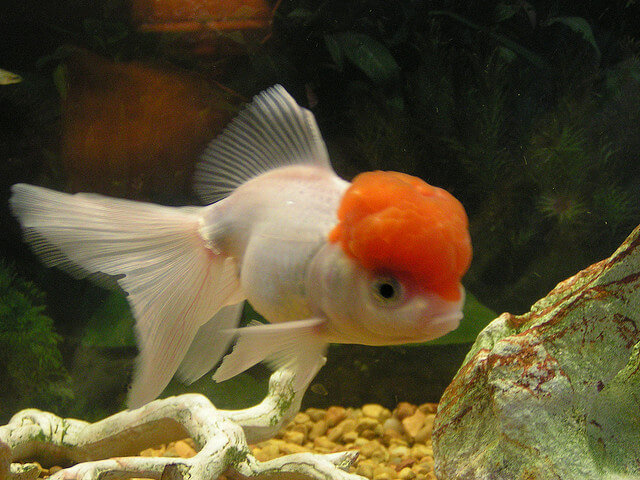Oranda Goldfish, with their distinctive appearance and captivating features, are a popular choice among goldfish enthusiasts. However, these fancy goldfish require specific care to ensure their health and well-being. In this comprehensive guide, we will explore the essential aspects of caring for Oranda Goldfish, from tank setup to feeding and breeding considerations.

Desired Characteristics
A high-quality Oranda Goldfish has a short, deep body that is about two-thirds of its body length. The dorsal fin should be high on its body, similar to the Ryukin Goldfish. All other fins should be long, flowing, and paired. The caudal fin should be divided and flow gracefully like the Veiltail Goldfish, with slightly squared trailing edges. The appearance of the caudal tail varies depending on the geographic location of the Oranda’s breeding. The caudal tail should be deeply forked in the Far East, but points are deducted for this in the West.
Oranda Goldfish are easily recognizable by the soft, wart-like hood cover around their head. As they mature, these hoods should develop around their head and face. Some Orandas develop more hood than others, while some may not develop any at all. A good hood will have lumps of similar size that cover the entire head back to its gills.
The Oranda Goldfish comes in a variety of colors, including metallic, solid (self-colored), multiple colors (variegated), and calico. The Redcap Oranda Goldfish should have a deep red hood and a silver body. Other colors include black, blue, chocolate, red, and silver.
Creating the Perfect Habitat
To provide a suitable environment for your Oranda Goldfish, careful attention must be given to their tank setup and surroundings.
Tank Size and Accommodation
Oranda Goldfish require ample space to thrive and move comfortably. A minimum tank size of 20 gallons per fish is recommended to ensure they have enough room to swim freely.
Tank Mates and Aquatic Plants
Oranda Goldfish should be housed with other slow-moving fancy breeds, as their delicate features and slower swimming speed make them vulnerable to competition during feeding. Aquatic plants, both live and artificial, not only enhance the aesthetics of the tank but also provide hiding spots and grazing opportunities.
Water Conditions and Maintenance
Maintaining optimal water parameters is crucial for the overall health and well-being of your Oranda Goldfish.
Temperature and Water Quality
Oranda Goldfish prefer temperatures between 68-74°F (20-23°C). Ensure the water temperature remains stable, as drastic fluctuations can stress the fish. Regular monitoring of ammonia, nitrite, nitrate levels, and pH is essential to maintain a healthy aquatic environment.
Filtration and Aeration
Investing in a reliable filtration system appropriate for the size of the tank is vital to remove waste and toxins, ensuring clean and oxygenated water. Regular cleaning and maintenance of the filter will help maintain optimal water quality.
Feeding and Nutrition
A well-balanced diet is crucial to promote the health and vibrant colors of your Oranda Goldfish.
Balanced Diet
Offer a varied diet that includes high-quality goldfish flakes or pellets as the staple food. Supplement their diet with occasional treats such as live or frozen foods like bloodworms, brine shrimp, or daphnia to provide essential nutrients and prevent dietary deficiencies.
Feeding Schedule
Feed your Oranda Goldfish small portions multiple times a day to prevent overeating and associated health issues like swim bladder problems and constipation. Remove any uneaten food after a few minutes to maintain water quality.
Breeding Considerations
Breeding Oranda Goldfish can be challenging due to the difficulty in determining their sex outside of the mating season. Here are some key points to consider:
Sex Determination
Males are generally smaller and more slender than females. During the mating season, males may develop white dots on the hoods of their heads, which should not be mistaken for goldfish ich.
Breeding Challenges
Successful breeding of Oranda Goldfish is rare, and obtaining high-quality fry is a challenge due to the complexity of breeding programs and genetic variations. Consult experienced breeders or seek professional guidance if attempting to breed Oranda Goldfish.
Conclusion
Oranda Goldfish, with their unique appearance and captivating features, require specific care and attention to thrive in an aquarium setting. By providing an optimal habitat, maintaining proper water conditions, and ensuring a balanced diet, you can enjoy the beauty and elegance of these remarkable goldfish. Remember to monitor their health, seek advice from experts, and be patient in your journey of caring for Oranda Goldfish.
Sources:
- “The Goldfish Book” by Lee J. D. Stannard
- “Goldfish Varieties and Genetics: Handbook for Breeders” by Joseph Smartt and James R. Bundell.
Reviewed By: Tim Winter

Tim Winter has a strong affection for pets and wildlife. His years of experience caring for various types of pets has led him to share his knowledge with others on the best practices in pet care. Tim holds a Bachelor of Science from the University of Oregon School of Journalism and Communications.
